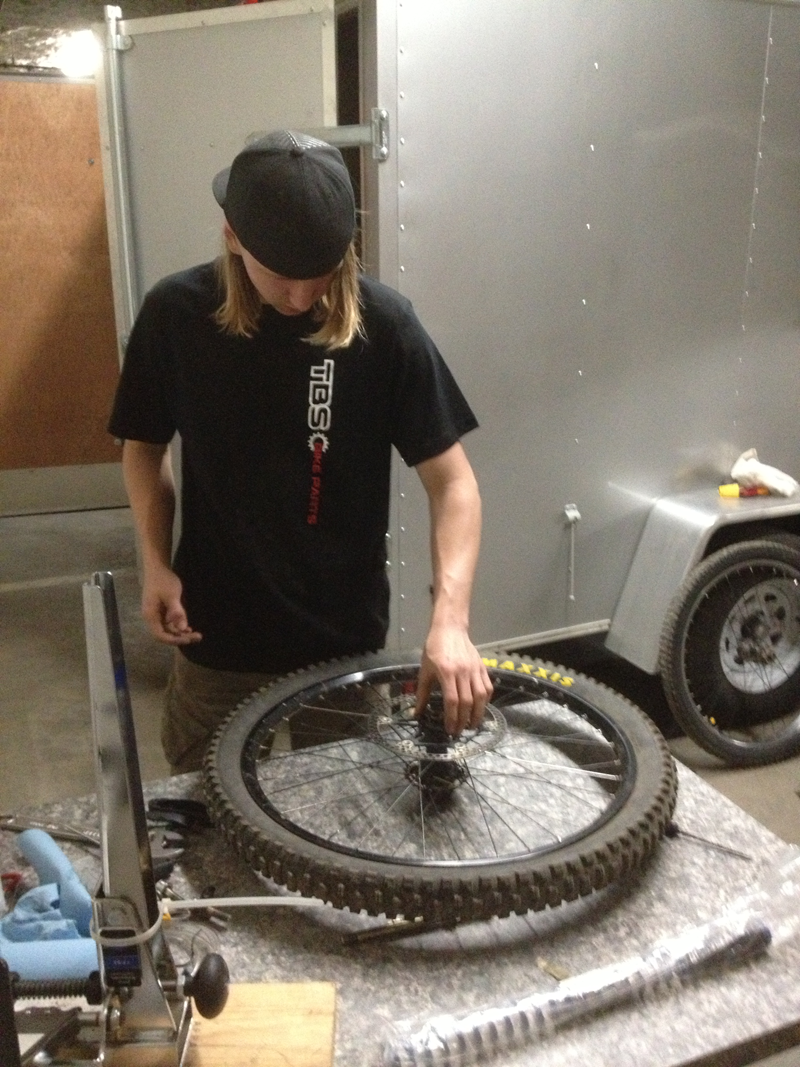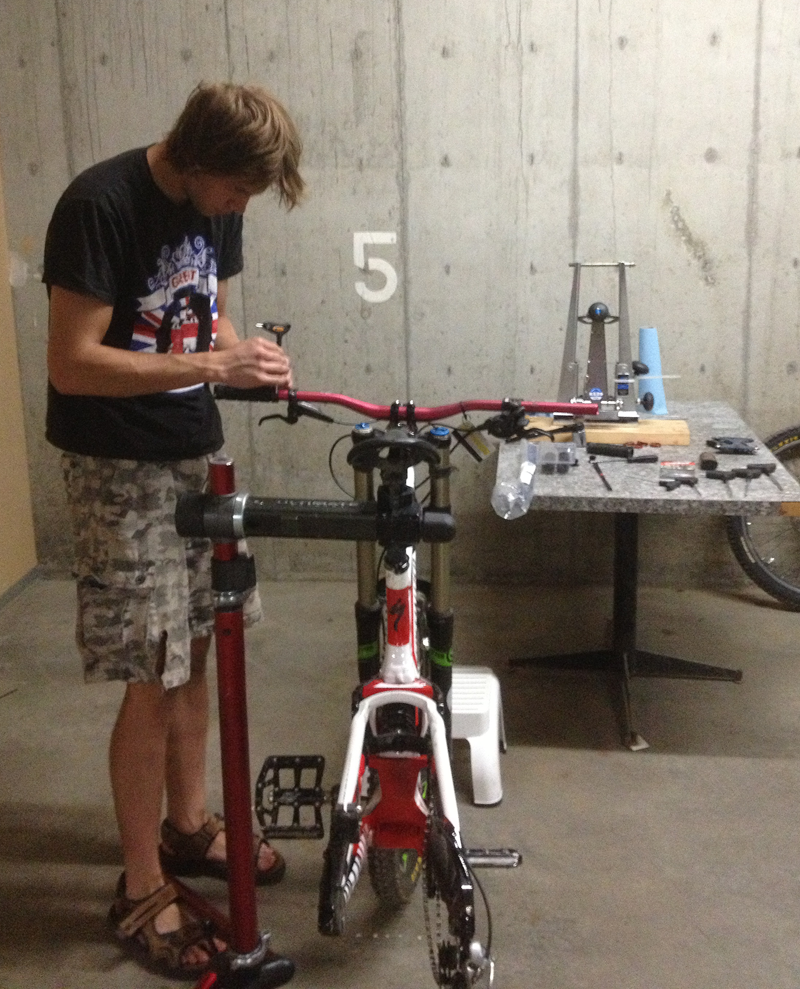Archives For intrinsic
Articles & Ideas mentioned in the video:
Intrinsic Motivation is Key to Student Achievement – But Schools Can Crush It – https://www.kqed.org/mindshift/53337/intrinsic-motivation-is-key-to-student-achievement-but-schools-can-crush-it
Additional Links:
These past several weeks my two boys, Levi and Caleb, have spent most of their days riding Silver Star and Whistler Bike Park, Whistler Aerodome and other DownHill and DirtJump locations in British Columbia. This type of riding is not only extremely hard on the human body (i.e. Levi’s concussion and recent shoulder injury and Caleb’s ongoing aching hands, too many bruises, scrapes and scratches to mentions) it may even be harder on the bikes. As result there is extensive daily maintenance and the all too often broken component that needs to be replaced as a result of bad hit, wipe out our simply the harsh terrain.
Up until this summer I had been supervising and directing this daily maintenance. Taking on a new position at BCIT means that I am not going to be able to ride with my boys on a daily basis and help them with their bike maintenance and repairs. That is why a recent Saturday morning at Silver Star confirmed that the gift of intrinsic motivation that I have been giving my boys for several years has not only finally been fully received, it has blossomed into the wonderful sight displayed in these pictures.
Two typical teenage boys (17 and 15) are not only cleaning, lubing and adjusting their high end DH bikes, they are spending sometimes up to 2-3 hours a day doing full repairs and preventative maintenance which ranges from replacing spokes, truing and tensioning wheels to changing fork oil, brake bleeds, replacing suspension bearings and every other aspect of maintaining and repairing their very expensive bikes. Most importantly they are doing it on their own without having to be told or directed. The gift of intrinsic motivation has finally been received.
While the title and initial focus of this blog post suggests that you can give someone intrinsic motivation I must concede the fact that you cannot give anyone intrinsic motivation. This type of motivation comes from within. You can however create the environment and influence the circumstances in which intrinsic motivation will not only emerge but will grow into a driving force.
I believe that we can help foster the growth and establishment of intrinsic motivation if we consider and foster the following five key contributing factors.
Modelling
James Dobson has repeatedly stated that “Values are not taught to our children; they are caught by them.” I suggest that intrinsic motivation is similar to values in that is not taught to our children but has to be caught by them. Ever since my boys first started riding their bikes they have also learned how to repair and maintain them–it is just something that I/we have always done. In addition to maintaining bikes I maintain our vehicles, our home and just about anything that we own. The years of rotating tires, changing oil, fixing the dishwasher, renovating and updating our homes and everything else that the boys were involved in helping their mom and dad do on a daily basis contributed to showing the boys how they could “catch” the intrinsic motivation required to work through the mundane tasks that are part of everyday life.
Expectations
Effective modelling will also convey or demonstrate what expectations, standards and criteria need to be met. Knowing what is expected and fulfilling those expectations is extremely important for children and teenagers because it will help them to develop responsibility and accountability. As adults our work is judged and often connected to our income so developing the ability to meet or exceed expectations for our children is not only very important, their future careers may also depend on this ability.
One of the biggest challenges with expectations is being realistic. The performance standard for an 10-12 year old child will not be the same as a 15-17 year old teenager or an adult. The desired end quality should not be compromised but the path to getting to that quality will depend on the age and skill level of your children so be patient. Unrealistic expectations are the source of too many disappointed fathers and children so remember when your 12 year old son or daughter is striving to meet their father’s expectations remember that they are just a 12 year old boy or girl. Similarly there is a point when challenging your 17 year old son or daughter to step up and perform as adult is crucial to their development.
Trust
The key to trust is letting go and letting your children do the task, make their own mistakes and learn from the situation. All too often we want to swoop in and direct and correct and interfere with the learning process. Or worse we think that it would be more time effective and less stressful to do the task ourselves or worse still outsource the job. When we trust our children to make breakfast, repair the doorknob, fix the flat tire or, in the case of my boys, build their own bikes from scratch we are telling them that we believe in them and that we value their effort and contribution. A father’s and mother’s trust is a major contributor to your child’s identity and to their intrinsic motivation. Knowing that someone else trusts and believes in them helps them to trust and believe in themselves. This instills confidence which is a fundamental contributor to personal motivation.
Ownership
Little boys and girls want to be like their mom and dad and have their own tool belts, hammers, appliances, bikes, cars and so many other things. This is one principle that I wish I would have fully grasped and understood sooner. When Caleb and Levi searched out and selected all the necessary components and built their own DH bikes up from a raw frame it really changed the way they approached maintaining their equipment. They now have a vested interest. They understand the work involved in putting the bike together and what it would take to replace or repair those components. More importantly, my boys now not only want to maintain their bikes they do so on their own and even appreciate preventative maintenance because they know the work that went into building up their bikes.
Consequences
Broken spokes are like deer; if you see one you inevitably will see another. A bad landing, a rock or root can cause a broken spoke and cut into prime riding time. Unfortunately, a poorly tensioned wheel will be more susceptible to damage than a well maintained wheel. There is often nothing better than natural consequences to motivate a young man to take the extra time necessary to properly tension his wheels to limit the downtime that can ruin an otherwise wonderful riding day. The idiom “an ounce of prevention is worth a pound of cure” is never fully appreciated until one is personally responsible for implementing that pound of cure. Letting your children suffer the consequences (as long as they aren’t life threatening) will be much more valuable to them in the long run than your intervening.
The lesson learned in the garage and on the mountain slopes, bike parks and dirt jump parks of BC have played a significant role in my sons’ acceptance of the gift of intrinsic motivation. As an intentional father it is my responsibility to create an environment at home, on the road and anywhere we are at where the above listed contributing factors will help my boys to grow into responsible men. Helping them with the gift of intrinsic motivation is just one part of this ongoing process.
Related Intentional Father Posts:
Becoming an Intentional Father
Catching the Openness to Change
In the Family Matters blog Kevin East recommends that we regularly tell our children:
1. You are my son/daughter. This states ownership on my part, and identity on theirs…
2. I love you. This is one of those phrases I don’t think I can say enough…
3. I am proud of you. My pride in them is not because of performance, but because they are mine…
My wife passed on this wonderful link and I have been thinking about the importance of these three powerful phrases in building our children’s self worth and identity. I have also been thinking about the role that these positive reinforcements play in establishing an effective learning environment. In my post Quality time is spelled “TIME” I referred to the James Dobson statement “morality, values and beliefs are not taught rather they are caught.” By positively reinforcing your children you are not only affirming their value and self worth you are modelling positive encouragement and motivating your children to do the same. The learning that can happen in this type of environment is not dependent upon rewarding performance or other external factors. The motivation to be the best one can be, which is a never ending learning process, comes from intrinsic factors of confidence, security and assurance.
While intrinsically motivating our own children, or children within our extended family, is part of our responsibilities as parents I suggest it is also part of our responsibility as teachers. Unfortunately, political correctness and other societal norms and conventions prevent us from telling our students that we love them, but we can still let them know that we truly value and respect them. We can let them know that by being our students they will be respected, valued and appreciated. We can also let them know that we are proud of them and by doing so we will have created the foundation for a learning environment that is based on intrinsically motivating our learners to grow and be the best that they can be.
This isn’t just a well meaning platitude. Intrinsically motivating our students to learn is much more effective than that performance based “carrot and stick” methods. If we recall Daniel Pink’s research revealed in his book, Drive, and the video below the carrot and stick are only useful for simple straight forward tasks that require little or no thought. But for tasks that are more complicated and require conceptual and creative thinking (deeper learning) the carrots and sticks do not work. Pink argues that the science shows that people are purpose driven, care about mastery very deeply and want to be self directed.

































